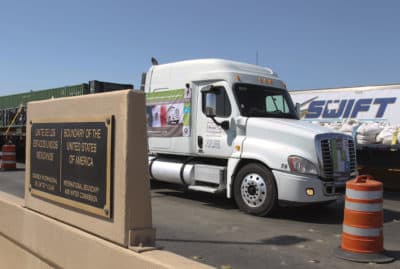BLOOMINGTON, Ind. — Although the U.S. goods trade deficit with Mexico is about $80 billion, the U.S. has a longstanding trade surplus with Mexico in terms of rail tonnage and a growing truck tonnage surplus over the past three years, according to just-completed analysis by FTR.
Using the Freight•cast forecasting model, FTR translated value-based trade data published by the Bureau of Transportation Statistics into transportation tonnage and loadings to and from Mexico and Canada.
The forecasting firm’s analysis of cross-border trade data has been ongoing for several months and happened to conclude around the time President Trump announced tariffs on all imports from Mexico, effective June 10.
“With China continuing to be problematic, we know that there had been some shifting of sourcing to Mexico, so potential tariffs on Mexican imports raise important questions,” said Eric Starks, chairman and CEO of FTR. “Either we lose this freight, see increased costs, or both.”
The U.S. rail sector has run a significant surplus of tonnage into Mexico for years, but U.S.-Mexico truck tonnage had been more balanced until 2016, when the U.S. trucking sector posted its first meaningful surplus since 2008. The picture looks a bit different regarding loads into and out of Mexico. Rail loadings are volatile year to year, but the U.S. runs a deficit of truck loads to the tune of about 800,000 a year.
Rail movements into and out of Mexico represent about 3.2% of all U.S. rail moves, and that portion has grown steadily since 2009. Excluding intermodal, U.S.-Mexico traffic represents about 5.5% of total U.S. rail moves, and that number has nearly doubled since 2009.
FTR estimates that truck loads into and out of Mexico make up just 1.5% of all U.S. truck loadings, but that share has risen by about 50% since 2009.
“Rail is more exposed than truck even though it has a smaller portion of overall crossborder freight,” Eric Starks said. “Changes in freight would be felt quicker by the rail sector. If we assume a retaliation by Mexico, rail could be hit further because Mexico potentially has other ready sources for some of the most important rail exports to Mexico, such as fuel and grain.”
With truck, while the share of overall truck volume dedicated to Mexico is small, a big piece of that are parts for vehicles, computers, and machinery.
“If the trucking freight went away, that in itself would not be a death knell for trucking, but the broader issue is the exponential impact on U.S. manufacturing,” Starks said.
FTR will discuss some of its top level findings during a complimentary State of Freight webinar on Key Issues in Transportation, scheduled for June 13.
To register, visit http://www.ftrintel.com/webinars. A more comprehensive analysis will also be available later this month to subscribers of FTR’s State of Freight INSIGHTS series.
For information on how to subscribe to State of Freight INSIGHTS and other FTR products, visit www.ftrintel.com or contact FTR by email at [email protected] or by phone at 888-988-1699, ext. 1.
The Trucker News Staff produces engaging content for not only TheTrucker.com, but also The Trucker Newspaper, which has been serving the trucking industry for more than 30 years. With a focus on drivers, the Trucker News Staff aims to provide relevant, objective content pertaining to the trucking segment of the transportation industry. The Trucker News Staff is based in Little Rock, Arkansas.








